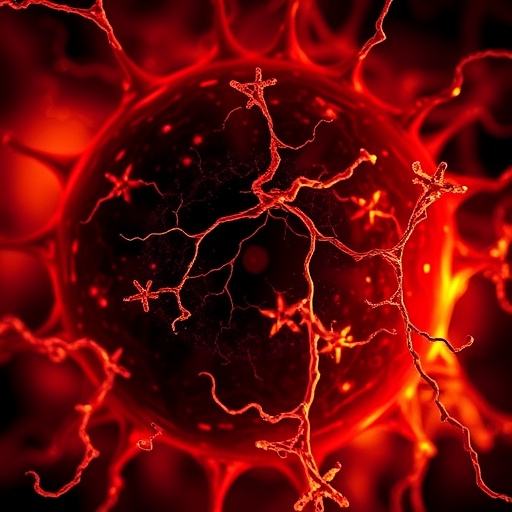
In a groundbreaking study published in Nature Communications, researchers have unveiled critical cellular mechanisms that precede photoreceptor cell death in inherited retinal disorders, offering fresh insights into the pathogenesis of these devastating diseases. The team, led by Newton, Halachev, Nguyen, and colleagues, demonstrated that disruptions in autophagy—a crucial cell recycling process—and heightened mitochondrial stress are early events that trigger necroptosis, a form of programmed necrotic cell death, in the photoreceptors of multiple mouse models mimicking human retinal degenerations.
Inherited retinal disorders (IRDs) encompass a broad spectrum of genetically heterogeneous conditions that lead to progressive vision loss and, ultimately, blindness. These disorders primarily affect photoreceptors, the light-sensitive neurons in the retina responsible for capturing visual information. Despite advances in genetic characterization, the precise molecular cascades leading to photoreceptor demise remain incompletely understood, impeding the development of effective therapeutics.
The study’s central contribution is its temporal delineation of the cellular events that unfold during retinal degeneration. Using state-of-the-art in vivo and ex vivo models, the investigators identified that impairments in autophagy—the lysosome-mediated degradation and recycling pathway essential for cellular homeostasis—occur well before observable photoreceptor cell death. This finding is significant because it suggests that autophagy dysfunction is not merely a consequence of retinal degeneration but a precipitating factor in disease pathology.
Autophagy serves as a cellular quality control mechanism, removing damaged organelles and proteins to maintain neuronal health. In highly metabolically active cells like photoreceptors, efficient autophagy is indispensable for coping with oxidative stress and metabolic demands. The researchers utilized biochemical assays and fluorescence imaging techniques to track autophagic flux in diseased retinas, revealing a marked decline in autophagic activity concurrent with accumulation of dysfunctional organelles and protein aggregates.
Concomitant with autophagy disruption, the study identified mitochondrial stress as a key early abnormality. Mitochondria, the powerhouse of the cell, are vital for ATP production and calcium homeostasis, particularly in energy-demanding cells such as photoreceptors. Disruptions in mitochondrial function can lead to excessive production of reactive oxygen species (ROS), bioenergetic failure, and the release of pro-death signaling molecules. The investigators showed elevated markers of mitochondrial stress, including altered membrane potential and increased oxidative damage, at pre-degenerative stages in their IRD models.
Importantly, the team linked these cellular stresses to the activation of necroptosis pathways in photoreceptors. Necroptosis is a regulated form of necrotic cell death distinguished by its molecular dependency on receptor-interacting protein kinases (RIPKs), contrasting with classical apoptotic mechanisms. Through selective molecular interventions and genetic perturbations, the authors demonstrated that inhibiting necroptosis machinery rescued photoreceptors and mitigated vision loss in mouse models, underscoring necroptosis as a promising therapeutic target.
This mechanistic unraveling of necroptosis following autophagy failure and mitochondrial distress adds crucial nuance to our understanding of photoreceptor cell death. Prior models mostly emphasized apoptosis-driven degeneration; however, this study foregrounds necroptosis as an alternative cytotoxic pathway with significant implications for neurodegeneration in the retina.
The use of multiple genetically engineered mouse models spanning distinct genetic mutations mimicking human IRDs strengthens the study’s translational relevance. Despite genetic heterogeneity inherent to IRDs, the uniform presence of autophagy impairment, mitochondrial overload, and necroptotic activation suggests these processes represent convergent pathological nodes downstream of diverse mutations.
On the methodological front, the authors integrated longitudinal optical coherence tomography (OCT) imaging to monitor retinal structure over time, correlating structural decline with molecular markers of cellular stress. Additionally, transcriptomic profiling revealed upregulation of genes related to inflammation and cell death, indicative of a neuroinflammatory milieu accompanying photoreceptor demise.
One intriguing facet of the findings is the suggestion that early interventions aimed at restoring autophagic flux or mitochondrial integrity could stymie the cascade leading to necroptosis. Pharmacological agents known to boost autophagy or protect mitochondrial function may thus offer neuroprotective benefits when administered prior to irreversible cell loss.
Furthermore, this research opens avenues to develop novel biomarkers for early retinal stress by detecting molecular signatures of autophagy failure and mitochondrial distress, potentially enabling pre-symptomatic diagnosis and monitoring of disease progression in patients with IRDs.
The study also raises important questions about the interplay between autophagy and mitochondrial quality control mechanisms such as mitophagy—the selective degradation of mitochondria. Dissecting how these pathways are dysregulated in retinal neurons could reveal additional therapeutic targets.
Beyond inherited conditions, understanding necroptotic mechanisms in photoreceptors bears implications for more common retinal degenerations like age-related macular degeneration (AMD) and diabetic retinopathy, where oxidative stress and metabolic dysfunction are also prevalent.
The work exemplifies the power of integrating cellular biology with advanced imaging and genetic tools to decode complex neurodegenerative processes. By illuminating the cascade from autophagy disruption to mitochondrial stress and onward to necroptotic cell death, Newton and colleagues set the stage for innovative strategies to preserve vision in IRDs.
Future research will need to explore the safety and efficacy of modulating these pathways in clinical settings, as well as the temporal therapeutic windows where intervention can yield maximal benefit. Additionally, expanding analyses to human retinal tissues will be crucial to validate findings from murine models.
Ultimately, this study represents a paradigm shift in how retinal neurodegeneration is conceptualized, moving from a narrow apoptosis-centric perspective to a broader framework that incorporates multiple regulated cell death pathways orchestrated by cellular stress responses.
By targeting the early molecular disruptions in autophagy and mitochondrial function, scientists hope to develop tailored neuroprotective therapies that can halt or slow the progression of debilitating visual impairment in inherited retinal disease patients worldwide.
As the global burden of retinal degenerations continues to rise, such mechanistic insights provide a beacon of hope towards the development of effective treatments that preserve sight and improve quality of life for millions.
Subject of Research: Inherited retinal disorders; photoreceptor cell death mechanisms; autophagy disruption; mitochondrial stress; necroptosis
Article Title: Autophagy disruption and mitochondrial stress precede photoreceptor necroptosis in multiple mouse models of inherited retinal disorders
Article References: Newton, F., Halachev, M., Nguyen, L. et al. Autophagy disruption and mitochondrial stress precede photoreceptor necroptosis in multiple mouse models of inherited retinal disorders. Nat Commun 16, 4024 (2025). https://doi.org/10.1038/s41467-025-59165-8
Image Credits: AI Generated
Tags: autophagy disruption in retinal cellscellular mechanisms of retinal degenerationearly events in photoreceptor cell deathgenetic factors in vision lossinherited retinal disorders mechanismslysosome-mediated degradation pathwaysmitochondrial stress and necroptosismouse models of retinal degenerationnecroptosis in inherited retinal disordersphotoreceptor cell death researchtherapeutic implications for retinal diseasesunderstanding retinal cell homeostasis





